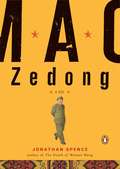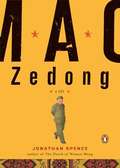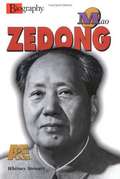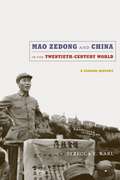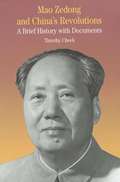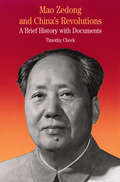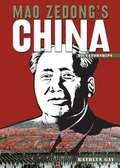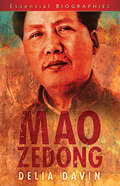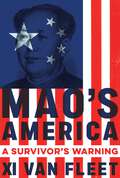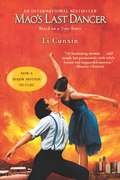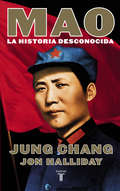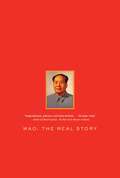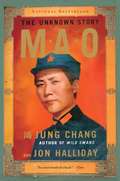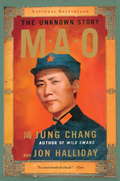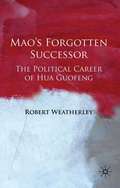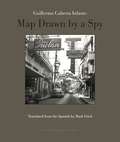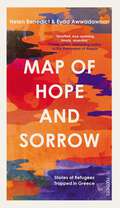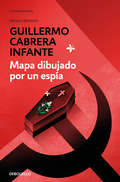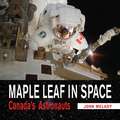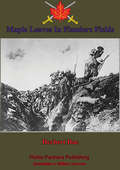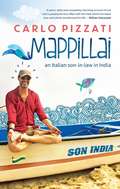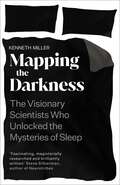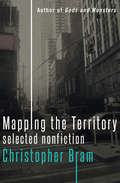- Table View
- List View
Mao Zedong
by Jonathan SpenceHistory of one of the most formidable and elusive rulers in modern history From humble origins in the provinces, Mao Zedong rose to absolute power, unifying with an iron fist a vast country torn apart by years of weak leadership, colonialism, and war.
Mao Zedong
by Jonathan Spence"Spence draws upon his extensive knowledge of Chinese politics and culture to create an illuminating picture of Mao. . . . Superb. ” (Chicago Tribune) From humble origins in the provinces, Mao Zedong rose to absolute power, unifying with an iron fist a vast country torn apart by years of weak leadership, colonialism, and war. This sharply drawn and insightful account brings to life this modern-day emperor and the tumultuous era that he did so much to shape. Jonathan Spence captures Mao in all his paradoxical grandeur and sheds light on the radical transformation he unleashed that still reverberates in China today. .
Mao Zedong
by Whitney StewartMao Zedong was one of the most powerful people in the world during his lifetime. Yet when he was born, China was still ruled by the Qing dynasty. Many people longed for a new China, however, and Mao led the way.
Mao Zedong and China in the Twentieth-Century World: A Concise History
by Rebecca E. KarlThroughout this lively and concise historical account of Mao Zedong’s life and thought, Rebecca E. Karl places the revolutionary leader’s personal experiences, social visions and theory, military strategies, and developmental and foreign policies in a dynamic narrative of the Chinese revolution. She situates Mao and the revolution in a global setting informed by imperialism, decolonization, and third worldism, and discusses worldwide trends in politics, the economy, military power, and territorial sovereignty. Karl begins with Mao’s early life in a small village in Hunan province, documenting his relationships with his parents, passion for education, and political awakening during the fall of the Qing dynasty in late 1911. She traces his transition from liberal to Communist over the course of the next decade, his early critiques of the subjugation of women, and the gathering force of the May 4th movement for reform and radical change. Describing Mao’s rise to power, she delves into the dynamics of Communist organizing in an overwhelmingly agrarian society, and Mao’s confrontations with Chiang Kaishek and other nationalist conservatives. She also considers his marriages and romantic liaisons and their relation to Mao as the revolutionary founder of Communism in China. After analyzing Mao’s stormy tenure as chairman of the People’s Republic of China, Karl concludes by examining his legacy in China from his death in 1976 through the Beijing Olympics in 2008.
Mao Zedong and China's Revolutions
by Timothy CheekWhether one views Mao Zedong as a hero or a demon, the "Great Helmsman" was undoubtedly a pivotal figure in the history of 20th-century China. The first part of this volume is an introductory essay that traces the history of 20th-century China, from Mao's early career up to the Chinese Communist Party's victory in 1949, through three decades of revolution, to Mao's death in 1976. The second half offers a selection of Mao's writings-- including such seminal pieces as "On the New Democracy" and selections from the "Little Red Book"-- and writings about Mao and his legacy by both his contemporaries and modern scholars. Also included are headnotes, a chronology, Questions for Consideration, photographs, a selected bibliography, and index.
Mao Zedong and China’s Revolutions: A Brief History With Documents (The Bedford Series In History And Culture)
by Timothy CheekWhether one views Mao Zedong as a hero or a demon, the "Great Helmsman" was, undoubtedly, a pivotal figure in the history of twentieth-century China, a man whose life and writings provide a fascinating window on the Chinese experience from the 1920s onward. <P><P>Part Mao biography, part historical overview of the turbulent story of China’s Communist revolutions, the introductory essay traces the history of twentieth-century China, from Mao’s early career up to the Chinese Communist Party’s victory in 1949, through three decades of revolution to Mao’s death in 1976. <P><P>The second half of the volume offers a selection of Mao’s writings — including such seminal pieces as "On New Democracy" and selections from the Little Red Book — and writings about Mao and his legacy by both his contemporaries and modern scholars. Also included are headnotes to the documents, a chronology, Questions for Consideration, 12 images, a selected bibliography, and an index.
Mao Zedong's China (Dictatorships)
by Kathlyn GayIn 1949, Mao Zedong came to power in China after a long and brutal civil war. He and his Chinese Communist Party immediately set out to transform their nation into a Communist state. They seized land from wealthy and middle-class farmers and distributed it to poor peasant farmers. The government also took over ownership of all industries. Citizens who resisted these changes were branded ?counterrevolutionaries, ? and thousands were imprisoned or executed. Within a few years, Mao had turned China into a totalitarian state, controlling all aspects of his citizens? daily lives. In the 1960s, he sought to wipe out what remained of traditional Chinese society by launching the Cultural Revolution. Millions died as the country erupted into spasms of mob violence. Yet, despite the tumult, Chairman Mao remained a revered, almost godlike figure, worshiped by his people. How did he do it? Learn more about one of the most powerful and controversial figures of the 20th century.
Mao Zedong: Essential Biographies
by Delia DavinMao Zedong, first chairman of the People's Republic of China, one of the founders of the Chinese Communist Party, and the architect of the Cultural Revolution, was active in Chinese politics for most of his 82 years, and became one of the most important revolutionary figures in the twentieth century. He spent the 1920s and 1930s struggling to build the Party. After the establishment of the People's Republic, he strove to impose his vision of socialism on his impoverished country, convinced that if the power of the people could be harnessed China could become an economically successful and egalitarian country. The Great Leap Forward which he initiated was, however, a disaster resulting in millions of deaths. Mao used the Cultural Revolution to re-impose his authority, his critics were persecuted and a personality cult was fostered. His Little Red Book sold over 740 million copies. This book is written by an eminent historian and offers the reader a powerful insight into the life and work of this unique man.
Mao's America: A Survivor's Warning
by Xi Van FleetAn inspiring survivor of Mao&’s Cultural Revolution in China makes a passionate case that history is eerily repeating itself as the Woke Revolution spreads across America. Xi Van Fleet lived through the horrors of the Chinese Cultural Revolution as a schoolgirl. Forced to the countryside with other young Chinese for re-education after high school, she later escaped communism and found freedom and new a life in America. But more than 30 years later, Xi disturbingly sees signs of the same Cultural Marxism that ravaged her birth country of China threatening to destroy the America she now calls home. This is her dire warning to the United States. Xi compellingly tells the story of two Cultural Revolutions: one driven by Mao during her childhood and the one unfolding in today&’s America from the progressive left. With captivating personal stories and extensive historic research, Xi reveals the stunning similarities of these two revolutions. This fascinating book shows readers that both revolutions: Use Marxist tactics of division, indoctrination, deception, coercion, cancelation, subversion and violence. Aim to destroy the foundation of the traditional culture to replace it with Marxist ideologies. Weaponize youth, using them as their means to an end. Share the same goal of achieving absolute power at the expense of the people. Lead to the same ending: loss of freedom and totalitarian rule. Readers will be captivated by the riveting personal story of a Chinese immigrant to the United States who overcame fear and reluctance to get involved in the movement to save America. Her political activism begins with a school board speech in 2021 against Critical Race Theory in Loudoun County, Virginia that unexpectedly goes viral and ignites national media attention. Xi now devotes her life to educating the American public on the shocking parallels between these two revolutions. Because only when Americans understand what is really happening will they rise up and resist the communist takeover of America.
Mao's Last Dancer (Movie Tie-In)
by Li CunxinFrom a desperately poor village in northeast China, at age eleven, Li Cunxin was chosen by Madame Mao's cultural delegates to be taken from his rural home and brought to Beijing, where he would study ballet. In 1979, the young dancer arrived in Texas as part of a cultural exchange, only to fall in love with America-and with an American woman. Two years later, through a series of events worthy of the most exciting cloak-and-dagger fiction, he defected to the United States, where he quickly became known as one of the greatest ballet dancers in the world. This is his story, told in his own inimitable voice.Watch a Video
Mao's Little Red Book
by Alexander C. CookMao Zedong's Little Red Book (Quotations from Chairman Mao) - a compilation of the Chinese leader's speeches and writings - is one of the most visible and ubiquitous symbols of twentieth-century radicalism. Published for the first time in 1964, it rapidly became the must-have accessory for Red Guards and revolutionaries from Berkeley to Bamako. Yet, despite its worldwide circulation and enduring presence there has, until now, been no serious scholarly effort to understand this seminal text as a global historical phenomenon. Mao's Little Red Book brings together a range of innovative scholars from around the world to explore the fascinating variety of uses and forms that Mao's Quotations has taken, from rhetoric, art and song, to talisman, badge, and weapon. The authors of this pioneering volume use Mao's Quotations as a medium through which to re-examine the history of the twentieth-century world, challenging established ideas about the book to reveal its remarkable global impact.
Mao: La Historia Desconocida
by Jung ChangLa biografía definitiva de Mao Zedong. Jung Chang y el historiador Jon Halliday, su marido, han escrito una biografía de Mao realmente sobrecogedora. Basada en diez años de investigación y en las entrevistas realizadas a muchas de las figuras que se movieron en los círculos más cercanos a Mao -y que hasta ahora no habían hablado- y con casi todo aquel que, fuera de China, mantuvo alguna relación significativa con el líder chino, ésta es la biografía de Mao más seria y acreditada que se ha escrito. Después de conquistar China, a partir de 1949 Mao tuvo el secreto objetivo de dominar el mundo. En la persecución de esta fantasía causó la muerte de 38 millones de personas en la mayor hambruna de la historia. En conjunto, bajo el gobierno de Mao perecieron, en tiempos de paz, más de 70 millones de seres humanos. La autora nos lleva a las sombrías estancias de su corte y nos deja observar el drama hasta en los rincones más recónditos. La personalidad de Mao y su relación con sus esposas, hijos y amantes salen a la luz por primera vez. Reseñas:«Pocos libros están destinados a cambiar la historia, pero este lo hará.»George Walden, Daily Mail «Jung Chang y Jon Halliday entran en una crítica salvaje que, basándose en numerosísimas fuentes -incluidas las soviéticas-, acabarán por barrer las miasmas de engaño e ignorancia que todavía envuelven la vida de Mao a los ojos de muchos ciudadanos occidentales.»Max Hastings, Sunday Telegraph «Una obra magistral. Esta magnífica biografía destruye metódicamente cada pilar de las reivindicaciones de Mao. Un logro.»Nicholas D. Kristof, The New York Times Book Review «Un triunfo. Un asombroso retrato de la tiranía, la degeneración, los asesinatos en masa y la promiscuidad, una batería de bombas para el revisionismo histórico y una soberbia pieza de investigación. La primera biografía privada y política del mayor monstruo de los monstruos.»Simon Sebag Montefiore, The Sunday Times «Lo que Chang y Halliday han hecho es inmenso y sobrepasa, dentro del ámbito de las biografías, todo lo que se había hecho anteriormente.»Jonathan Mirsky, The Independent «Chang y Halliday arrojan una luz nueva y reveladora sobre cada uno de los episodios de la tumultuosa vida de Mao. Un libro estupendo.»Michael Yahuda, The Guardian «Este libro es una bomba atómica.»Donald Morrison, TIME «Una obra que pone de manifiesto que comunismo y destrucción son sinónimos, pese a la admiración que la mencionada ideología recibió y sigue recibiendo desde determinadas instancias académicas y culturales.»Alfredo Crespo, El imparcial
Mao: The Real Story
by Alexander V. Pantsov Steven I. LevineThis major new biography of Mao uses extensive Russian documents previously unavailable to biographers to reveal surprising details about Mao’s rise to power and his leadership in China. Mao Zedong was one of the most important figures of the twentieth century, the most important in the history of modern China. A complex figure, he was champion of the poor and brutal tyrant, poet and despot. Pantsov and Levine show Mao’s relentless drive to succeed, vividly describing his growing role in the nascent Communist Party of China. They disclose startling facts about his personal life, particularly regarding his health and his lifelong serial affairs with young women. They portray him as the loyal Stalinist that he was, who never broke with the Soviet Union until after Stalin’s death. Mao brought his country from poverty and economic backwardness into the modern age and onto the world stage. But he was also responsible for an unprecedented loss of life. The disastrous Great Leap Forward with its accompanying famine and the bloody Cultural Revolution were Mao’s creations. Internationally Mao began to distance China from the USSR under Khrushchev and shrewdly renewed relations with the U.S. as a counter to the Soviets. He lived and behaved as China’s last emperor.
Mao: The Unknown Story
by Jung Chang Jon HallidayThe most authoritative life of the Chinese leader every written,Mao: The Unknown Storyis based on a decade of research, and on interviews with many of Mao's close circle in China who have never talked before -- and with virtually everyone outside China who had significant dealings with him. It is full of startling revelations, exploding the myth of the Long March, and showing a completely unknown Mao: he was not driven by idealism or ideology; his intimate and intricate relationship with Stalin went back to the 1920s, ultimately bringing him to power; he welcomed Japanese occupation of much of China; and he schemed, poisoned, and blackmailed to get his way. After Mao conquered China in 1949, his secret goal was to dominate the world. In chasing this dream he caused the deaths of 38 million people in the greatest famine in history. In all, well over 70 million Chinese perished under Mao's rule -- in peacetime.
Mao: The Unknown Story
by Jung Chang Jon Halliday"Ever since the spectacular success of Chang's Wild Swans we have waited impatiently for her to complete with her husband this monumental study of China's most notorious modern leader. The expectation has been that she would rewrite modern Chinese history. The wait has been worthwhile and the expectation justified. This is a bombshell of a book."-Chris Patten, the last governor of Hong Kong, in The Times (London)Based on a decade of research and on interviews with many of Mao's close circle in China who have never talked before-and with virtually everyone outside China who had significant dealings with him-this is the most authoritative life of Mao ever written. It is full of startling revelations, exploding the myth of the Long March, and showing a completely unknown Mao: he was not driven by idealism or ideology; his intimate and intricate relationship with Stalin went back to the 1920s, ultimately bringing him to power; he welcomed Japanese occupation of much of China; and he schemed, poisoned and blackmailed to get his way. After Mao conquered China in 1949, his secret goal was to dominate the world. In chasing this dream he caused the deaths of 38 million people in the greatest famine in history. In all, well over 70 million Chinese perished under Mao's rule-in peacetime.Combining meticulous research with the story-telling style of Wild Swans, this biography offers a harrowing portrait of Mao's ruthless accumulation of power through the exercise of terror: his first victims were the peasants, then the intellectuals and, finally, the inner circle of his own advisors. The reader enters the shadowy chambers of Mao's court and eavesdrops on the drama in its hidden recesses. Mao's character and the enormity of his behavior toward his wives, mistresses and children are unveiled for the first time.This is an entirely fresh look at Mao in both content and approach. It will astonish historians and the general reader alike.From the Hardcover edition.
Mao’s Forgotten Successor
by Robert WeatherleyHua Guofeng succeeded Mao in 1976, emerging almost out of nowhere following an unexceptional career in Shanxi and Hunan. In just over two years, Hua had been eclipsed by Deng Xiaoping, a more politically shrewd, progressive and charismatic figure. If Hua's rise to power was remarkable, then this fall was even more so.
Map Drawn by A Spy
by Guillermo Cabrera Infante Mark FriedFound in an envelope in Guillermo Cabrera Infante's house after his death in 2005, Map Drawn by a Spy is the world-renowned writer's autobiographical account of the last four months he spent in his country. In 1965, following his mother's death, Infante returns to Cuba from Brussels, where he is employed as a cultural attaché at the Cuban embassy. When a few days later his permission to return to Europe is revoked, Infante begins a period of suspicion, uncertainty, and disillusion. Unable to leave the country, denied access to party officials, yet still receiving checks for his work in Belgium, Infante discovers the reality of Cuba under Fidel Castro: imprisonment of homosexuals, silencing of writers, the closing of libraries and newspapers, and the consolidation of power. Both lucid and sincere, Map Drawn by a Spy is a moving portrayal of a fractured society and a writer's struggles to come to terms with his national identity.
Map of Hope and Sorrow: Stories of Refugees Trapped in Greece
by Helen Benedict Eyad AwwadawnanThe stories of refugees who fled violence or persecution only to become trapped in the worst refugee camps in Europe.Helen Benedict, award-winning British-American professor of journalism at Columbia University, teams up with Syrian writer and refugee, Eyad Awwadawnan, to present the stories of five refugees who have endured long and dangerous journeys from the Middle East and Africa to Greece. Hasan, Asmahan, Evans, Mursal and Calvin each tell their story, tracing the trajectory of their lives from homes and families in Syria, Afghanistan, Nigeria and Cameroon to the brutal refugee camps, where they are trapped in a strange and hostile world. These are compelling, first-person stories of resilience, suffering and hope, told in a depth rarely seen in non-fiction, partly because one of the authors is a refugee himself, and partly because both authors spent years getting to know the interviewees and winning their trust. The women and men in this book tell their stories in their own words, retaining control and dignity, while revealing intimate and heartfelt scenes from their lives.
Mapa dibujado por un espía
by Guillermo Cabrera InfanteLas memorias más políticas de Guillermo Cabrera Infante, crónica de su desencanto ante la Revolución y su decisión de exiliarse definitivamente Libro de memorias casi secreto e inédito a la muerte del autor, Mapa dibujado por un espía narra los apuros que vivió Guillermo Cabrera Infante en el verano de 1965, cuando regresó a Cuba desde Bélgica para asistir al entierro de su madre. Fue el momento de abrir los ojos a la vertiente totalitaria de la Revolución, cuyas autoridades le negaron la visa de salida, obligándolo a permanecer cuatro meses en la isla hasta encontrar una nueva vía de escape a Europa. La crónica de ese tiempo muerto refleja un mundo espectral y desmoronado, así como el desconcierto de quien no consigue despertar de las pesadillas de la Historia. Reseñas:«La narración implacable de un proceso moral y el testimonio de una decisión valiente.»Enrique Macari, Letras Libres «Conmovedor, lúcido, elegante, honrado en la desnudez con la que se muestra ante el lector.»Ernesto Calabuig, El Cultural
Maple Leaf in Space: Canada's Astronauts
by John MeladyMarc Garneau, Roberta Bondar, Julie Payette, Robert Thirsk, Chris Hadfield, and more recently, Guy Laliberté, the founder of Cirque de Soleil, all have one thing in common: they’re some of the very few Canadians who have been in space. The launch of a spaceship is terribly exciting. That’s why thousands of people come to watch. They laugh, cheer, and applaud as the rocket rises. They see the smoke, steam, and white-hot fire as millions of litres of fuel burn in seconds. They feel the chest-thumping impact of the sound. Then they stare upward for a long time until they can no longer see even a tiny speck in the distant sky. By that time, the craft is in space. Canada’s astronauts come from across the nation: from farms, cities, and little towns. They went to large schools and to small ones. Maple Leaf in Space showcases these amazing Canadians who have ventured off our planet and delivers some of the thrill of what that’s like.
Maple Leaves In Flanders Fields
by Admiral Sir Albert Hastings Markham K.C.B. Herbert RaeIt was the celebrated Canadian physician and poet Lieutenant Colonel John McCrae that wrote the famous lines "In Flanders fields the poppies blow" as an opening to his famous poem 'In Flanders Fields'. His countrymen had shed their blood copiously in fighting the Germans on the Western Front and earned an outstanding reputation as fighting troops. Despite perhaps lacking a bit of 'spit and polish', they would be exchanged by no Allied commander for other troops.His compatriot George Gibson wrote 'Maple Leaves in Flanders Fields' as a lasting testament of the achievements and character of his fellow Canadian soldiers. His book is not a bold statement of the engagements, battles and victories that the Canadians were involved in, but rather the story of the Canadians by a Canadian with a humorous tone and self-effacing modesty. Although there are many battle scenes depicted with great skill and vividness, it is perhaps the moments of quiet that display the character of the Canadian troops most; for example, an exchange at a hand-over of the line:Sentry. "Halt! Who goes there?"Answer. "First Grenadiers."Sentry. "Pass, first Grenadiers; all's well." Sentry. "Halt! Who goes there?"Answer. "What the Hell is that to you?" Sentry. "Pass, Canadians; all's well."A fine testament to the achievements and noble sacrifice of the Canadian Corps on the Western Front.Author -- Gibson, George Herbert Rae, 1881-1932Introduction --Admiral Sir Albert Hastings Markham, K.C.B. (11 November 1841 - 28 October 1918)Text taken, whole and complete, from the edition published in New York, Dutton, 1916.Original Page Count - xi and 268 pages.
Mappillai
by Carlo PizzatiMappillai—‘son-in-law’ in Tamil—is the rollicking story of journalist Carlo Pizzati, a European living with his in-laws in urban Chennai and with his wife in rural Paramankeni. When in Paramankeni, he finds himself in the company of fishermen and goat-herders, in a house where 3G asserts itself in a corner of the bathroom and electricity courses through rooms in fits and starts. At one level, Mappillai is deeply personal. With beguiling candour, Carlo tells of his struggle with two extreme, contradictory responses to India—fascination and suspicion—and his awkward attempts at cruising through a maze of bribery, bureaucracy and traffic. Yet, at another level, the book offers a glimpse into the world of expats in contemporary India by introducing us to a host of colourful ‘firangi friends’—from those who are overwhelmed by this nation’s noise and colour; to those who ‘go native’ in kurtas; to those who believe that India is vast enough to accommodate their diverse selves as dreamers or yogis or artists. But, beyond all of this, Mappillai is the story of India. Over his decade long stay in this nation—one that has taken him north and south, west and east—Carlo has witnessed a land in flux—from the gloom and doom of 2008 when the New India dream shattered, to the heady optimism of 2015 with promises of ‘acche din’, right up to today, marked by the domination of anti-Romeo squads and gau-rakshaks. With wry humour and jollity, wisdom and acceptance, Mappillai offers an intimate capsule of contemporary Indian history—of the concomitant Hinduization and Westernization of India, intertwined with the Indianization of a European!
Mapping the Darkness: The Visionary Scientists Who Unlocked the Mysteries of Sleep
by Kenneth Miller&‘Fascinating, magisterially researched, and brilliantly written.&’ Steve Silberman, author of Neurotribes Thirty-two days underground. No heat. No sunlight. 4 June 1938. Nathaniel Kleitman and his research student make their way down the seventy-one steps leading to the mouth of Mammoth Cave. They are about to embark on one of the most intrepid and bizarre experiments in medical history, one which will change our understanding of sleep forever. Undisturbed by natural light, they will investigate what happens when you overturn one of the fundamental rhythms of the human body. Together, they enter the darkness. When Kleitman first arrived in New York, a penniless twenty-year-old refugee, few would have guessed that in just a few decades he would revolutionise the field of sleep science. In Mapping the Darkness, Kenneth Miller weaves science and history to tell the story of the outsider scientists who took sleep science from the fringes to a mainstream obsession. Reliving the spectacular experiments, technological innovation, imaginative leaps and single-minded commitment of these early pioneers, Miller provides a tantalising glimpse into the most mysterious third of our lives.
Mapping the Territory: Selected Nonfiction
by Christopher BramThe first collection of nonfiction from the author Tony Kushner calls &“one of the best novelists writing in the world today&” Over a thirty-year period, novelist Christopher Bram witnessed, and lived through, the powerful experiences of coming out, the AIDS epidemic, gay marriage, and the social changes that have occurred in lower Manhattan. From the title piece, which maps the state of gay fiction, to &“A Body in Books,&” about the gay books that changed the author&’s life, the essays in Mapping the Territory form a coherent autobiographical account of Bram&’s life. This work wouldn&’t be complete without &“Homage to Mr. Jimmy,&” his account of how his novel Father of Frankenstein grew from his imagination and writing into the Oscar-winning movie Gods and Monsters. Mapping the Territory is a thoroughly engaging and compelling look into a great American writer.
